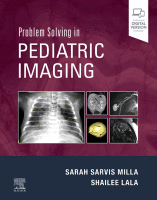Physical Address
304 North Cardinal St.
Dorchester Center, MA 02124

The observation that a child has a limp is not a diagnosis, but rather a manifestation of an underlying problem. A limping child has altered gait, which may or may not also be antalgic. This is a commonly encountered phenomenon…

Pelvic pain in a preadolescent or adolescent girl can be a diagnostic challenge. Ovarian causes, including torsion of the ovary, ovarian cysts, and paraovarian cysts, must be distinguished from nonovarian diagnoses, such as appendicitis, renal calculi, urinary tract infection, and…

Acknowledgments I am grateful to Robert Lebowitz, Rhonda Johnson, and Jane Choura for their invaluable help in preparing this chapter and, always, for their friendship. Key point: Distinguishing normal from pathological causes of urinary tract dilation (UTD) is one of…

When a child presents with scrotal pain and swelling, the most important determination is between surgical and nonsurgical causes of the symptoms. This often cannot be differentiated with certainty from the physical examination and clinical history. Imaging can, therefore, be…

Abdominal masses in children present with variable symptoms, including abdominal pain, abdominal distention, and palpable mass on physical examination. Palpable abdominal masses are a common presenting problem on pediatric outpatient services. Although many pediatric patients ultimately have benign causes for…

In pediatrics, one of the most common presenting symptoms to the pediatrician or emergency department is abdominal pain. It is a source of much consternation for parents and is often an extrapolated symptom by the parent based on how the…

Vomiting is common in infancy. Parents reporting that their infant is vomiting may be dealing with regurgitation from nonpathological “spitting up” after feeds, which can be normal in newborns and usually resolves over time. Clinicians fear vomiting secondary to obstruction,…

Congenital heart disease (CHD) can be a challenge for the imagers because it requires a profound knowledge of the morphological and functional characteristics of a broad range of heart defects. Moreover, complex CHD often involves palliative or corrective surgical intervention…

The mediastinum is the most common location for intrathoracic masses in children. Mediastinal masses in pediatric patients are composed of a heterogeneous group of lesions ranging from benign, asymptomatic, and incidentally detected lesions to malignant, symptomatic, and potentially life-threatening masses.…

Respiratory distress is one of the most common complaints seen in the pediatric urgent care or emergency department setting. Clinically, respiratory distress is characterized by tachypnea, increased respiratory effort, and poor oxygenation. Radiographs remain the primary imaging modality for evaluation…